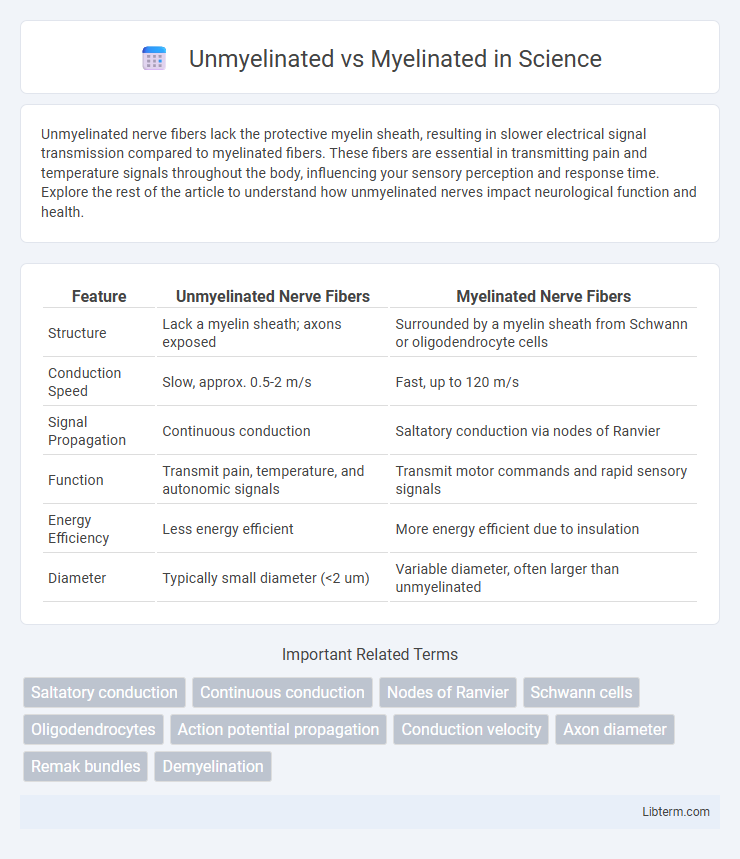Unmyelinated nerve fibers lack the protective myelin sheath, resulting in slower electrical signal transmission compared to myelinated fibers. These fibers are essential in transmitting pain and temperature signals throughout the body, influencing your sensory perception and response time. Explore the rest of the article to understand how unmyelinated nerves impact neurological function and health.
Table of Comparison
| Feature | Unmyelinated Nerve Fibers | Myelinated Nerve Fibers |
|---|---|---|
| Structure | Lack a myelin sheath; axons exposed | Surrounded by a myelin sheath from Schwann or oligodendrocyte cells |
| Conduction Speed | Slow, approx. 0.5-2 m/s | Fast, up to 120 m/s |
| Signal Propagation | Continuous conduction | Saltatory conduction via nodes of Ranvier |
| Function | Transmit pain, temperature, and autonomic signals | Transmit motor commands and rapid sensory signals |
| Energy Efficiency | Less energy efficient | More energy efficient due to insulation |
| Diameter | Typically small diameter (<2 um) | Variable diameter, often larger than unmyelinated |
Introduction to Nerve Fibers
Nerve fibers are classified into unmyelinated and myelinated types based on the presence of a myelin sheath, which is a lipid-rich layer that insulates axons and enhances signal conduction. Myelinated fibers enable rapid transmission of electrical impulses through saltatory conduction, while unmyelinated fibers conduct signals more slowly via continuous propagation. The distinction between these fibers is crucial for understanding nervous system function, nerve signal velocity, and neural pathway efficiency.
Definition of Myelinated Nerves
Myelinated nerves are nerve fibers wrapped in a protective myelin sheath composed of lipid-rich Schwann cells or oligodendrocytes, which enhances the speed of electrical signal transmission through saltatory conduction. This myelin insulation reduces signal loss and increases conduction velocity compared to unmyelinated nerves, where signals propagate more slowly along the axon surface. The presence of myelin is crucial for efficient nervous system function, particularly in motor and sensory pathways.
Definition of Unmyelinated Nerves
Unmyelinated nerves are nerve fibers lacking the myelin sheath, a fatty insulating layer that speeds up electrical signal transmission in myelinated nerves. These fibers conduct impulses more slowly due to the absence of this insulation, typically found in the peripheral nervous system and associated with functions such as pain and temperature sensation. Unmyelinated nerves play a crucial role in autonomic nervous system responses and sensory input where rapid signal conduction is less critical.
Structural Differences
Unmyelinated nerve fibers lack the insulating myelin sheath, resulting in slower signal transmission due to continuous conduction along the axon. Myelinated nerve fibers are wrapped with multiple layers of myelin produced by Schwann cells or oligodendrocytes, enabling rapid saltatory conduction as electrical impulses jump between nodes of Ranvier. Structurally, myelinated axons exhibit thicker insulation and distinct nodes, while unmyelinated axons have direct exposure to extracellular fluid, affecting their conduction velocity and energy efficiency.
Function and Signal Transmission
Myelinated neurons feature a fatty myelin sheath that enables rapid saltatory conduction, allowing electrical impulses to jump between nodes of Ranvier, significantly increasing signal transmission speed. Unmyelinated neurons lack this sheath, resulting in slower, continuous conduction as the nerve impulse travels along the entire axon membrane. The presence of myelin enhances neural efficiency and signal fidelity, crucial for complex and rapid responses in the nervous system.
Speed of Impulse Conduction
Myelinated nerve fibers conduct impulses significantly faster than unmyelinated fibers due to the presence of the myelin sheath, which enables saltatory conduction by allowing the action potential to jump between nodes of Ranvier. Unmyelinated fibers rely on continuous conduction along the entire axon length, resulting in slower impulse transmission. The conduction velocity in myelinated fibers can reach up to 120 m/s, while unmyelinated fibers typically conduct at speeds around 0.5 to 2 m/s.
Distribution in the Human Body
Unmyelinated nerve fibers are predominantly found in the autonomic nervous system, such as postganglionic neurons controlling visceral functions and small-diameter C fibers responsible for transmitting pain and temperature signals. Myelinated fibers are concentrated in areas requiring rapid signal conduction, including motor neurons in the somatic nervous system and large sensory fibers in the dorsal columns of the spinal cord. The differential distribution of unmyelinated versus myelinated fibers reflects their specialized roles in fast versus slow signal transmission across the human body.
Roles in Health and Disease
Unmyelinated nerve fibers primarily facilitate slow, continuous signal transmission essential for autonomic functions and pain sensation, while myelinated fibers enable rapid, efficient electrical conduction crucial for motor control and sensory processing. Damage or loss of myelin in diseases like multiple sclerosis leads to impaired nerve signaling, resulting in muscle weakness and sensory deficits, whereas dysfunction in unmyelinated fibers is implicated in chronic pain disorders and autonomic neuropathies. Understanding the distinct roles of myelinated and unmyelinated fibers informs therapeutic strategies targeting demyelination and neuropathic pain.
Advantages and Disadvantages
Unmyelinated nerve fibers transmit signals more slowly but are energy-efficient and support sustained, continuous conduction suitable for autonomic functions. Myelinated fibers feature faster signal propagation due to saltatory conduction between nodes of Ranvier, enhancing rapid response and precise motor control. However, myelination requires higher metabolic resources and maintenance, making unmyelinated fibers advantageous for long-term, steady-state signaling in peripheral nervous systems.
Clinical Relevance and Disorders
Unmyelinated fibers, lacking a myelin sheath, conduct nerve impulses slower and are predominantly involved in transmitting dull, aching pain and temperature sensations, making them significant in chronic pain disorders like diabetic neuropathy. Myelinated fibers enable rapid signal transmission, crucial for motor control and sharp pain detection, with disorders such as multiple sclerosis causing demyelination that leads to muscle weakness and sensory deficits. Understanding the differential impact on unmyelinated versus myelinated fibers aids in diagnosing and targeting treatments for neuropathies, neurodegenerative diseases, and pain syndromes.
Unmyelinated Infographic

 libterm.com
libterm.com